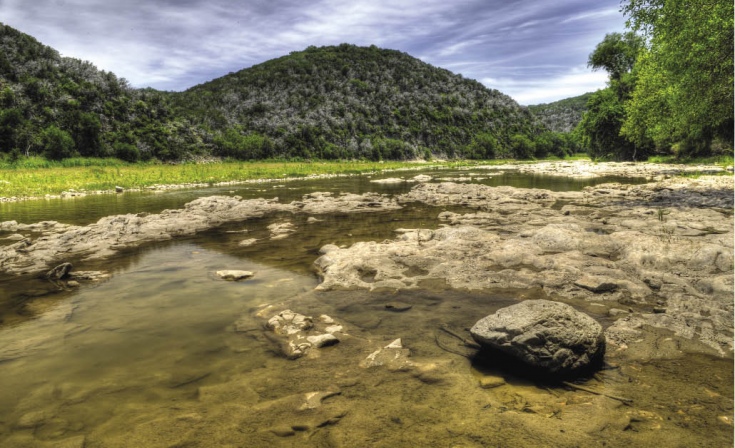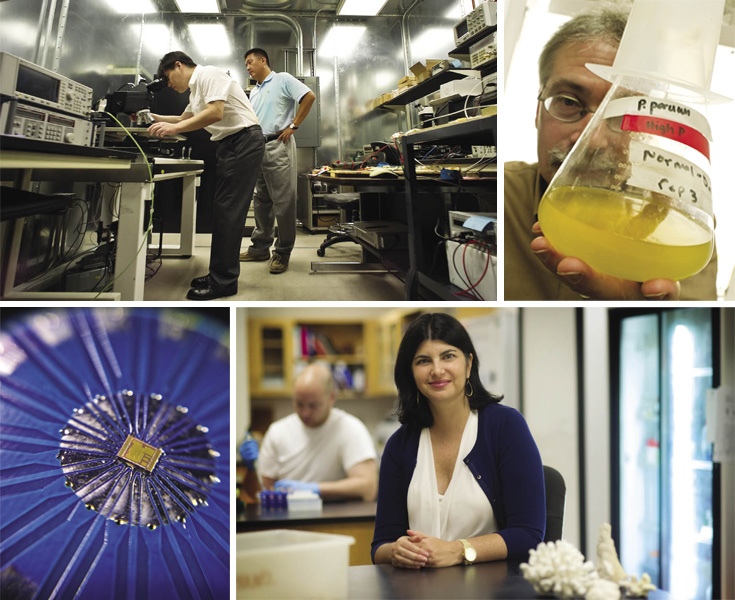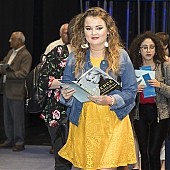DEADLY FLOW
Golden algae has spread to the Colorado River and numerous other Texas rivers, killing an estimated 20 million fish and crippling the state’s multibillion-dollar nature tourism industry.
Chase A. Fountain / TPWD © 2009

Water Worlds
Researchers protect vital water systems from harmful blooms, manmade contaminants, and climate change.
The Brazos river rises fast against the eastern border of Stonewall County, then winds 840 miles across Texas, through small towns and old ranches, before emptying into the Gulf of Mexico near Freeport. Once a crossing for settlers, the Brazos now pumps millions of tourism dollars into local economies while providing the region with much of its water for drinking and farming.
In recent years, however, massive blooms of golden algae have threatened the storied river, killing millions of fish and devastating the economy in towns that rely on it for survival. A team of Texas scientists is creating a plan to battle the deadly golden algae. The research is central to the state’s tourism industry and the health of the Brazos and other waterways.
“The economic impact has been tremendous,” biology Professor James Grover says. “Recreational amenities are a very big business to these river communities, and they need healthy, abundant fish populations.”
Research like Dr. Grover’s thrives at UT Arlington, where professors study ways to make water safer for people and wildlife. Scientists and engineers are developing methods to analyze water quality, monitor biological toxins, and protect oceans against climate change. Their work has far-reaching importance. In Texas, the Brazos and other rivers have been ravaged by a persistent drought. Worldwide, water use is growing at more than twice the population rate.
As increased demand burdens the world’s water supply, maintaining its safety is even more critical.
NOT SO GOLDEN
Golden algae first appeared in the United States in 1985, in Texas’ Pecos River, when hundreds of fish washed up on the shores of the Rio Grande basin. Named for their yellow tint, the one-celled algae can emit toxins that suffocate fish.
AQUATIC ADVOCATES
Top left: Researchers in Hyeok Choi’s lab are developing a method to quickly identify harmful algae in fresh and salt water. Bottom left: Dr. Choi’s team is building a wireless sensor to spot toxins and signal scientists. Top right: James Grover is battling golden algae in Texas rivers. Bottom right: Laura Mydlarz is studying how climate change affects coral reefs.

Within years, the algae spread throughout the state to the Colorado, Canadian, Wichita, Red, and Brazos river systems, killing an estimated 20 million fish and crippling Texas’ multibillion-dollar nature tourism industry.
“People across the state really started paying attention,” Grover says. “Before we could stop the fish kills, we had to determine the ecological factors contributing to the algae blooms.”
Working with colleagues at Texas A&M University and Baylor University, Grover used laboratory and field experiments plus mathematical modeling to determine that the golden algae thrived in cool seasons and in water with high salt content and low flow. The team then developed three possible solutions: increasing the hydraulic flow of rivers with pumps, manipulating the water’s pH by adding sulfuric acid, or changing the chemistry by adding ammonia.
All proved successful in small-scale experiments, and Grover hopes to conduct a larger pilot study soon. Although it would be costly, adding solar-powered pumps to increase the flow would be ideal.
“In coming years, we know less water will be available to us. A great deal of work on water resources will need to be done,” he says. “This makes it imperative that we protect the quality of the water we do have.”
IDENTIFYING TOXINS WIRELESSLY
Like Grover, environmental engineer Hyeok Choi focuses on harmful algae. Every summer, a thick layer of toxic blooms develops on Lake Erie and other bodies of water, killing thousands of fish and swamping beaches with a foul smell. These blooms can emit powerful biological toxins called microcystins, which are poisonous to fish, plants, and people.
Dr. Choi is developing a way to quickly identify the blooms and toxins in fresh and salt water. He has received more than $500,000 from the National Institutes of Health and the National Science Foundation to create chip-sized wireless sensors that will spot the toxins and signal scientists.
“This will be an enormous step forward that will protect water, plants, wildlife, and people,” the civil engineering assistant professor says. “Our old way of monitoring no longer makes sense.”
Currently, researchers must collect samples from the lake and return to the lab to analyze them. Under Choi’s plan, wireless sensors in lakes known for harmful algal blooms, like Lake Erie and Lake Michigan, will send reports to the laboratory. Sungyong Jung, a UT Arlington electrical engineering associate professor, is building the sensors, in cooperation with Sang-Yeon Cho of New Mexico State University and Jung-Min Park of Virginia Tech.
To test the devices, Choi will release microcystins into a small, controlled body of water, such as a fish tank. Eventually, aided by the Environmental Protection Agency, the research team will place sensors where there’s a high concentration of toxins. Water samples will then be collected and the results compared to those of Choi’s network.
“In the future, water providers like cities and treatment facilities will be able to use this information to make safer drinking water,” Choi says. “This is a timely and cost-effective early-warning system. We will know immediately if there is a problem so it can be addressed.”
PROTECTING OCEANS
“In coming years, we know less water will be available to us. This makes it imperative that we protect the quality of the water we do have.”
Laura Mydlarz inspects a small piece of sea fan, which resembles a delicate web. A marine biologist, she studies how climate change, specifically temperature stress, affects coral reefs.
Taken from the Caribbean near Puerto Rico, the coral sample will be pulverized into a powder with a mortar and pestle before protein and RNA are extracted. Dr. Mydlarz and fellow scientists then will conduct tests to determine the immunity of the coral and its gene expression. Results thus far are worrisome.
“Rising temperatures do negatively affect a coral’s immune system,” the biology associate professor says. “When the water gets warmer, even by just one degree, the coral’s ability to fight disease is suppressed. We see many coral dying due to disease outbreaks.”
In collaboration with professors at the University of Puerto Rico at Mayaguez, Mydlarz also is examining the coral that successfully resist disease. The National Science Foundation is funding her work.
“We want to know what they are doing right, versus the more sensitive reefs,” she says. “We might be able to use that knowledge to help the dying reefs.”
Loss of coral reefs would be catastrophic for the vast marine life that depends on them, she explains. Additionally, scientists believe the reefs have potential to produce natural products for human use, such as drugs and antibacterial compounds.
“But if reef loss continues at its current rate,” Mydlarz warns, “we may not get the chance to find them.”
TESTING THE WATERS
More immediate threats to the environment concern Purnendu “Sandy” Dasgupta—namely, the hundreds of contaminants that enter the water supply through naturally occurring chemicals and minerals, fertilizers and pesticides, manufacturing processes, and even sewer overflows.
The Jenkins Garrett Professor of Chemistry and Biochemistry recently developed a more efficient way of measuring ions in solutions, which has led to a device that improves water quality testing.
Marketed as the Thermo Scientific Dionex QD detector, the device uses ion chromatography, the process of separating and detecting ions for analysis. Dr. Dasgupta is a pioneer of this technique, which also can be used to monitor air quality, drug development, and manufacturing.
“I have long been fascinated by the potential of this technology,” he says. “It marries two things I love: analytical chemistry and instrumentation.”
Components in organic and inorganic compounds carry different levels of charged ions. Phosphate, for example, is triple-charged, while chloride is singly charged. The new charge detector uses a membrane-based separation, or desalting, technology that detects ions in proportion to their charge and concentration.
By combining charge and conductivity detection—the latter being the traditional method for measuring ions—Dasgupta’s machine greatly improves performance.
He is working with Bingcheng Yang, a member of his research group, and Kannan Srinivasan, technical director for Thermo Fisher Scientific Inc. The UT System Board of Regents and California-based Dionex Corp., Thermo Fisher’s parent company, share the patent.
“We see this as a game-changer,” says Thermo Fisher Vice President Chris Pohl, a chromatography chemist. “Charge detection, when combined with suppressed conductivity detection, can be used as a confirmatory tool or as a complementary detector to provide additional analytical information.”
This isn’t Dasgupta’s only water-related research. Using many of the same methods, he has developed an analyzer for arsenic in drinking water that is less expensive, more effective, and more environmentally friendly than methods involving lead and mercury.
Arsenic poisoning, or arsenicosis, affects millions of people worldwide in places as varied as the United States and China. Arsenic, which has no odor or taste, enters water supplies from natural deposits in the earth or from agricultural and industrial practices. No place is more affected than Bangladesh, where more than 70 million are at risk of drinking contaminated water, according to the World Health Organization.
Dasgupta was moved to help after touring Bangladesh villages. He saw firsthand the devastation of chronic arsenic exposure, which can cause heart disease and cancers of the liver, kidney, bladder, and skin.
“In time,” he says, “I hope this green analyzer will be able to help the poorest countries prevent a scourge of diseases.”




















